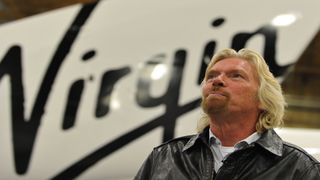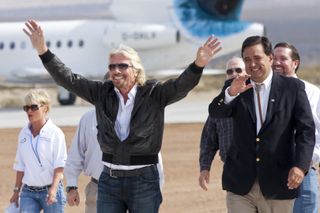Richard Branson: Music mogul & space tourism entrepreneur
Richard Branson is shooting for the stars.

Richard Branson is a British entrepreneur who has founded multiple companies, including a private spaceflight venture, Virgin Galactic.
Branson has a reputation as a risk-taker and self-promoter. He has arrived at press conferences in spacesuits; drove a tank on New York's Fifth Avenue; crossed the English Channel in an amphibious car; and base jumped from the top of a hotel. And for his latest stunt, he aims to fly to space this Sunday (July 11) aboard the company's VSS Unity space plane.
Branson is heavily involved in his companies and serves as their key spokesperson, often appearing in his companies commercials. As a business person, Branson seeks to catch trends just as they are beginning. He registered the Virgin Galactic name in 1999, while the Ansari X-Prize for suborbital spaceflight was still under way. And as an unapologetic stuntman, Branson initially signed himself and his children up for the company's first commercial flight into space before deciding to join this month's landmark test flight.
Early life
Branson had an entrepreneurial bent from a young age, which initially defied the wishes of his father. Ted Branson told his son to be a lawyer.
"Later, I felt awful because I had said to him just what my father had said to me. So, the next weekend, I walked him up and down the lawn once again and told him to forget everything I'd said," Branson's father reportedly said, according to a 2011 obituary in the Daily Telegraph,
But the younger Branson had other goals in mind. He dropped out of high school and launched a music business in 1972. He reportedly gave it the name "Virgin" because most of his employees were new to business.
"In 1977, we signed the Sex Pistols and we went on to sign many household names from Culture Club to the Rolling Stones, helping to make Virgin Music one of the top six record companies in the world," Branson wrote in his blog's autobiography.
Over the decades, Branson added Virgin-branded businesses in fields such as aerospace, mobile phones, cosmetics and trains. For his "services to entrepreneurship," Branson was knighted by Prince Charles in 2000.
Branson's interest in space also started early. He was just 19 when Apollo 11 touched down on the moon. According to Virgin Galactic's website, Branson watched the landings on televisionalong with his family. He "determined that he too will one day experience the wonder of space," Virgin Galactic wrote.
However, getting to space would require a shift in technology and deep pockets on the part of Branson. As of March 2012, Forbes estimates Branson has a fortune of $4.2 billion from his various ventures. The technology changes simply took time.

Space inspiration
In 1995, commercial rocket launching for satellites was still a young industry, and human spaceflight appeared to be a long way off – unless you were working for a government agency.
Still, Branson was mulling over how to get humans into space. According to Virgin Galactic, Branson had a conversation with Apollo 11 astronaut Buzz Aldrin concerning what technology would be best.
The two reportedly agreed that sending the spacecraft up from a plane launch – rather than from the ground – would be both cheaper and safer. Branson then directed Virgin employees to keep an eye on the advances of space technology.
Fast-forward to 1996, and the market began to change. The Ansari X-Prize was launched in a quest to award $10 million to the first non-governmental organization able to send a reusable spacecraft – with people aboard – into space twice in two weeks.
Branson registered the "Virgin Galactic" name in 1999 as he was searching for technology that could bring his brand into space.
The X Prize
Three years later, Branson figured he had found a winner. Some of his employees excitedly told him about Scaled Composites, which was building SpaceShipOne to compete for the X-Prize.
Scaled Composites was then solely receiving financing from Paul Allen, a co-founder of Microsoft. Branson quickly agreed to work with Allen's firm, Mojave Aerospace Ventures, to license SpaceShipOne's technology in preparation for a commercial fleet of spacecraft.
In late September 2004, Branson announced that Virgin would sponsor the SpaceShipOne X-Prize flights. Not only that, but if Scaled Composites won, Virgin was prepared to back the company's construction of commercial spacecraft.
"Virgin Galactic was now in a position to commence a program of work that would result in the world's first affordable space tourist flights in two to three years' time," the company announced. Registrations opened immediately.
Within days, the X-Prize competition was over. SpaceShipOne safely returned to Earth for the second time on Oct. 4, 2004. It was time to get to work on that spaceline.

Accidents and delays
In December 2005, the state of New Mexico officially offered Virgin Galactic a taxpayer-funded $225 million facility, called Spaceport America, where the company could put its world headquarters and run test flights and spaceflights.
Construction and development occupied Virgin's attention in the following years. But spaceflight, and especially human-rated spaceflight, is a complicated business. A fatal explosion and development delays pushed back the date for crewed spaceflight several times.
Throughout the delays, Branson has projected a positive image of spaceflight. His customers have hung on; only a few have backed out of the project, and there are at least 530 people who have made deposits for their $200,000 ticket to space.
Branson has also delivered regular updates of progress, often traveling to see the spacecraft as it takes shape. He periodically invites the paying customers of Virgin Galactic to take part in events, or to attend press conferences, to both keep them posted and to offer the vision of customer support.
Related: How Virgin Galactic's SpaceShipTwo works (infographic)
The first rocket-powered test flight of SpaceShipTwo took place in April 2013 and another followed in September 2013, then another in January 2014. Each flight went well, with Enterprise zooming high in the sky faster than the speed of sound.
But tragedy struck during the fourth rocket-powered flight, on Oct. 31, 2014, when the vehicle broke apart. The incident killed co-pilot Michael Alsbury and injured pilot Peter Siebold.
A blog post from Branson in early January 2015 said he briefly had doubts about whether it was a good idea to continue with SpaceShipTwo's development after the crash — but his commitment was renewed when he returned to California's Mojave Desert.

Spaceflight
The company continued with a series of unpowered glide test flights, which means the spacecraft is released from its carrier ship and glides to the ground (including a 2017 successful first test of the new re-entry system) until April 5, 2018, when the company turned on the engines of a SpaceShipTwo vehicle for the first time in 3.5 years. This powered flight saw VSS Unity soar to a maximum altitude of 84,271 feet (25,686 m). During its descent, the crew successfully deployed the feathering system before touching down safely on the spaceport runway.
"@virgingalactic back on track," Virgin Galactic founder Richard Branson tweeted after the test. "Successful powered flight, Mach 1.6. Data review to come, then on to the next flight. Space feels tantalizingly close now."
In February of 2021, Virgin Galactic announced that, although additional test flights were subject to further delays, the company plans to take its first tourists to space in early 2022. In the same announcement the company unveiled its first SpaceShip III, the next generation of its tourist vehicles that is intended to begin testing alongside the launch of the VSS Unity's first commercial flights.
Additional resources
- Visit the Virgin Galactic official website.
- Check out Spaceport America's website.
- Watch videos from Virgin Galactic on their YouTube channel.
This article was updated on July 8, 2021 by Space.com Reference Editor Kimberly Hickok.
Join our Space Forums to keep talking space on the latest missions, night sky and more! And if you have a news tip, correction or comment, let us know at: community@space.com.
Get the Space.com Newsletter
Breaking space news, the latest updates on rocket launches, skywatching events and more!

Elizabeth Howell (she/her), Ph.D., is a staff writer in the spaceflight channel since 2022 covering diversity, education and gaming as well. She was contributing writer for Space.com for 10 years before joining full-time. Elizabeth's reporting includes multiple exclusives with the White House and Office of the Vice-President of the United States, an exclusive conversation with aspiring space tourist (and NSYNC bassist) Lance Bass, speaking several times with the International Space Station, witnessing five human spaceflight launches on two continents, flying parabolic, working inside a spacesuit, and participating in a simulated Mars mission. Her latest book, "Why Am I Taller?", is co-written with astronaut Dave Williams. Elizabeth holds a Ph.D. and M.Sc. in Space Studies from the University of North Dakota, a Bachelor of Journalism from Canada's Carleton University and a Bachelor of History from Canada's Athabasca University. Elizabeth is also a post-secondary instructor in communications and science at several institutions since 2015; her experience includes developing and teaching an astronomy course at Canada's Algonquin College (with Indigenous content as well) to more than 1,000 students since 2020. Elizabeth first got interested in space after watching the movie Apollo 13 in 1996, and still wants to be an astronaut someday. Mastodon: https://qoto.org/@howellspace
